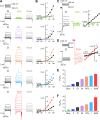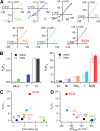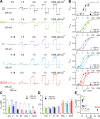Interactions between permeation and gating in the TMEM16B/anoctamin2 calcium-activated chloride channel
- PMID: 24863931
- PMCID: PMC4035747
- DOI: 10.1085/jgp.201411182
Interactions between permeation and gating in the TMEM16B/anoctamin2 calcium-activated chloride channel
Erratum in
- J Gen Physiol. 2014 Jul;144(1):125
Abstract
At least two members of the TMEM16/anoctamin family, TMEM16A (also known as anoctamin1) and TMEM16B (also known as anoctamin2), encode Ca(2+)-activated Cl(-) channels (CaCCs), which are found in various cell types and mediate numerous physiological functions. Here, we used whole-cell and excised inside-out patch-clamp to investigate the relationship between anion permeation and gating, two processes typically viewed as independent, in TMEM16B expressed in HEK 293T cells. The permeability ratio sequence determined by substituting Cl(-) with other anions (PX/PCl) was SCN(-) > I(-) > NO3 (-) > Br(-) > Cl(-) > F(-) > gluconate. When external Cl(-) was substituted with other anions, TMEM16B activation and deactivation kinetics at 0.5 µM Ca(2+) were modified according to the sequence of permeability ratios, with anions more permeant than Cl(-) slowing both activation and deactivation and anions less permeant than Cl(-) accelerating them. Moreover, replacement of external Cl(-) with gluconate, or sucrose, shifted the voltage dependence of steady-state activation (G-V relation) to more positive potentials, whereas substitution of extracellular or intracellular Cl(-) with SCN(-) shifted G-V to more negative potentials. Dose-response relationships for Ca(2+) in the presence of different extracellular anions indicated that the apparent affinity for Ca(2+) at +100 mV increased with increasing permeability ratio. The apparent affinity for Ca(2+) in the presence of intracellular SCN(-) also increased compared with that in Cl(-). Our results provide the first evidence that TMEM16B gating is modulated by permeant anions and provide the basis for future studies aimed at identifying the molecular determinants of TMEM16B ion selectivity and gating.
© 2014 Betto et al.
Figures








References
Publication types
MeSH terms
Substances
LinkOut - more resources
Full Text Sources
Other Literature Sources
Miscellaneous

